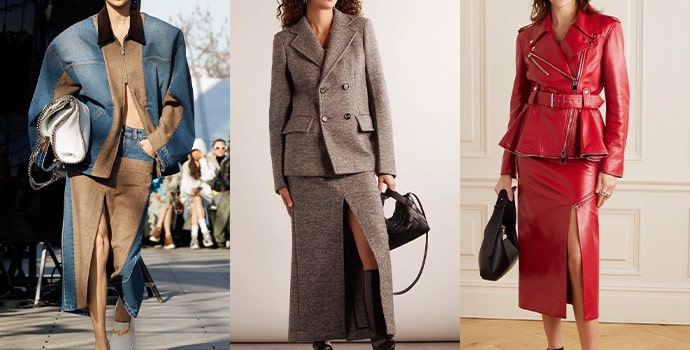Fabric Fit Guide: How to Pick Branded Clothing That Moves With You
The Relevance of Lasting Garments: Exactly How It Impacts the Atmosphere and Your Storage room
Sustainable garments is significantly identified for its crucial role in decreasing the environmental influence of the quick fashion sector. By concentrating on environment-friendly products and honest production methods, it deals with pressing ecological concerns. This shift not only profits the planet however additionally influences consumer selections, bring about a much more thoughtful method to closet administration. Comprehending these characteristics raises crucial inquiries about fashion's future and individual duty in shaping it.
The Environmental Impact of Fast Style

Benefits of Lasting Materials
Sustainable materials provide significant benefits, specifically with green textile options that decrease ecological damage. These materials additionally show toughness and durability, decreasing the need for regular replacements. As an outcome, they add to a much more sustainable fashion business and promote accountable customer habits.
Eco-Friendly Fabric Options
While the apparel industry has long been connected with fast trends and ecological harm, the surge of environment-friendly textile selections provides a transformative possibility. Sustainable products such as natural cotton, hemp, and Tencel have actually obtained popularity as a result of their lower environmental impact. These materials are usually created without hazardous chemicals and need less water, decreasing their carbon impact - Branded Clothing. Additionally, several eco-friendly materials are biodegradable, contributing to a circular economy by decreasing waste. Choosing sustainable products not only sustains environmentally accountable practices however additionally advertises healthier ecosystems. As consumers come to be more mindful of their purchasing power, the need for environment-friendly textiles encourages brands to introduce and take on more lasting manufacturing methods, eventually profiting the earth and future generations
Toughness and Longevity Benefits
Lots of customers are increasingly acknowledging the durability and longevity benefits of sustainable products in their clothes options. Unlike traditional materials, sustainable materials such as organic cotton, hemp, and recycled polyester are engineered to hold up against deterioration, causing garments that last much longer. This minimized regularity of replacement not only saves customers cash in time but also diminishes waste produced by rapid style. In enhancement, sustainable clothes typically employs environmentally friendly production approaches that improve material stamina, adding to a decrease in the overall carbon footprint. By investing in durable clothing, consumers can grow an extra lasting wardrobe while appreciating high-grade pieces that keep their aesthetic and functionality over time. Resilience and durability stand as vital advantages of choosing lasting products.
Minimizing Waste Via Lasting Practices
Decreasing waste in the fashion business can be accomplished with innovative techniques such as upcycling and repurposing materials. Furthermore, adopting minimal wardrobe strategies urges consumers to prioritize quality over amount, ultimately reducing clothes consumption. With each other, these methods add considerably to a more lasting apparel model.
Upcycling and Repurposing Materials
Upcycling and repurposing products have actually become cutting-edge methods in the fashion business, changing discarded fabrics into useful brand-new products. This technique not only minimizes waste but also encourages imagination and originality in garments design. By taking old garments and materials, developers can create distinct items that mirror personal design while decreasing the need for brand-new resources. Furthermore, upcycling frequently calls for much less energy and water contrasted to conventional production procedures, substantially decreasing the ecological footprint of fashion. As consumers end up being more knowledgeable about sustainability, the appeal of upcycled clothing remains to climb, promoting a circular economic climate. Inevitably, these methods add to a more sustainable future, where style prioritizes environmental health and wellness over rapid manufacturing and usage.

Minimal Closet Techniques
As people increasingly seek to minimize their environmental impact, adopting minimalist wardrobe techniques has actually gained traction as an effective method to sustainable fashion. These strategies emphasize high quality over quantity, encouraging customers to curate a smaller sized collection of versatile, durable garments. By focusing on timeless items that can be mixed and matched, individuals can lower the regularity of purchases and eventually decrease waste.Additionally, minimalism promotes conscious usage, advising customers to assess the ethical and environmental implications of their choices. This strategy not just fosters an extra lasting way of life but also streamlines daily decision-making relating to clothes. As people welcome minimalist concepts, they add to a style society that values sustainability and responsible consumerism, inevitably leading to an extra eco-conscious society.
The Duty of Honest Labor in Lasting Style
While numerous customers are increasingly knowledgeable about the environmental repercussions of their clothing options, the importance of moral labor methods in lasting fashion can not be overlooked. Honest labor incorporates fair earnings, safe working problems, and respect for employees' rights, developing the foundation of accountable style manufacturing. Brand names that prioritize moral labor not only boost areas yet also established a standard for liability in the industry.Moreover, the integration of honest methods fosters transparency, making it possible for customers to make enlightened choices concerning their purchases. This technique contrasts sharply with quick fashion's unscrupulous labor models, which typically prioritize earnings over people. By sustaining business dedicated to moral labor, consumers contribute to a system that values human dignity together with environmental sustainability. Ethical labor is not merely an add-on; it is vital to the more comprehensive objective of sustainable fashion, ensuring that the pursuit for eco-friendliness does not come at the cost of human legal rights.
The Impact of Sustainable Apparel on Carbon Emissions
Sustainable clothes has the potential to significantly reduce carbon emissions related to the garment industry. Standard garment production contributes notably to greenhouse gas emissions, largely as a result of energy-intensive manufacturing processes and using non-renewable sources. In comparison, sustainable fashion concentrates on environmentally friendly materials, such as organic cotton or recycled fibers, which frequently require much less energy to produce.Moreover, sustainable brand names often tend to adopt more reliable production methods, minimizing waste and lowering general emissions. By focusing on sturdiness and classic style, lasting garments motivates consumers to purchase less regularly, additional minimizing the carbon footprint related to overconsumption.Additionally, lots of sustainable brand names are dedicated to transparency in their supply chains, enabling consumers to make educated selections that line up with their worths. Inevitably, moving towards sustainable clothing can lead to a significant reduction in carbon emissions, contributing to a much healthier world and an extra sustainable future for the fashion business.
Supporting Regional Economic Climates With Lasting Selections
The shift toward lasting clothing not only addresses environmental problems but likewise considerably benefits local economic situations. By picking sustainable style, customers typically sustain little organizations and local artisans, improving community resilience. These ventures typically operate a smaller sized scale, focusing on workmanship and moral techniques over mass production.Investing in locally made lasting garments cultivates work creation and boosts you can try here economic growth within areas. As customers become much more conscious of the ecological influence of their acquisitions, they significantly look for items that show their values. This demand urges local producers to adopt sustainable techniques, adding to a circular economy.Moreover, supporting neighborhood businesses reduces transportation discharges, lining up with eco-conscious consumer behavior. The interconnectedness of lasting garments and regional economic climates underscores the necessary function that individual selections play in advertising both environmental and economic health. By fostering these local links, neighborhoods can flourish while likewise functioning towards an extra lasting future.
Transforming Your Wardrobe: Tips for a Sustainable Closet
As people look for to minimize their environmental influence, transforming a closet right into a lasting wardrobe becomes a vital action. One efficient strategy is to review existing clothes, maintaining only items that are used consistently and that straighten with sustainability goals. Prioritizing top quality over quantity is essential; purchasing long lasting pieces from environment-friendly brands can substantially minimize waste.Additionally, incorporating used products can breathe brand-new life into a closet while minimizing ecological damage. Organizing apparel swaps with close friends or contributing extra products can better promote sustainability.When purchasing, individuals ought to look for materials that are organic, recycled, or biodegradable, and stay clear of fast fashion stores - Branded Clothing. Practicing mindful intake by attentively taking into consideration each acquisition can contribute to a much more lasting way of life. By applying these pointers, one can develop a wardrobe that reflects personal style while supporting environmental stewardship
Frequently Asked Concerns
Exactly How Can I Recognize Lasting Clothing Brands?
To identify sustainable apparel brand names, one need to look into products made use of, look for accreditations like Fair Trade, and analyze the brand's transparency about their production procedures, labor practices, and environmental impact, guaranteeing honest and green techniques are focused on.
What Are the Expenses Associated With Sustainable Fashion?
The prices linked with lasting style can vary considerably. Higher manufacturing expenditures, moral sourcing, and eco-friendly products frequently lead to increased market prices, which may discourage some consumers while interesting eco mindful consumers.
Can Lasting Apparel Be Fashionable and trendy?
Lasting garments can certainly be stylish and trendy. Designers progressively focus on innovative materials and honest production approaches, verifying that style and sustainability can coexist. Customers now have varied alternatives that blend aesthetic appeals with environmental consciousness.
Just How Does Washing Clothing Affect Their Sustainability?
Washing clothes considerably impacts sustainability by consuming water and energy, contributing to contamination, and creating microplastic release. Constant washing can break down textiles, reducing their lifespan and boosting the demand for replacements, inevitably intensifying ecological problems.
What Is the Life Expectancy of Lasting Clothes Contrasted to Fast Fashion?
The life-span of sustainable clothes generally goes beyond that of fast style products, usually long linked here lasting numerous years due to high quality products and workmanship. In contrast, quick style garments might break down promptly, necessitating more frequent substitutes. Sustainable apparel is progressively acknowledged for its vital function in minimizing the environmental influence of the rapid style industry. While numerous consumers are progressively aware of the ecological consequences of their clothing choices, the importance of honest labor methods in lasting style can not be ignored. Branded Clothing. Lasting apparel has the prospective to greatly decrease carbon emissions associated with the fashion industry. In comparison, lasting style focuses on environmentally friendly materials, such as natural cotton or recycled fibers, which typically call for much less power to produce.Moreover, sustainable brands tend to take on a lot more effective manufacturing techniques, lessening waste and reducing total exhausts. By prioritizing sturdiness and timeless layout, sustainable clothing encourages customers my company to purchase much less often, more lowering the carbon footprint associated with overconsumption.Additionally, lots of sustainable brand names are dedicated to transparency in their supply chains, allowing consumers to make enlightened selections that line up with their values